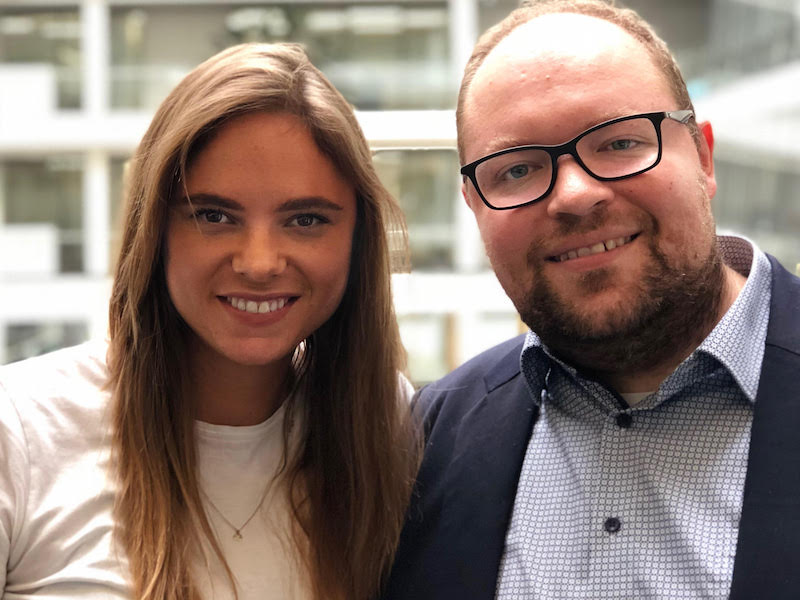Maja Pawinska Sims 01 Oct 2018 // 7:31AM GMT

Siemens campaigns communications manager Johanna Prestele and senior communications manager, digital communications Joachim Hechinger are at the helm of a number of projects around digitisation and bringing data to life, for the company and its customers. They spoke to the Holmes Report about using data for brand storytelling, including their latest Reimagine the Game project, in partnership with The Economist Group: converting the energy and noise of FC Bayern Munich fans at football matches into visuals, using pioneering sound-mapping technology.
How did the Reimagine the Game project come about?
JP: Data and capturing human insights are really important for us. We’ve been partnering with FC Bayern Munich since July last year, supporting them with energy management, mobility and building technology solutions for arenas. We’re also in continuous discussion with them on updating the arena and digital solutions and were thinking about how to use these skills to come up with new insights into the game, so we partnered with The Economist Group and data design agency Signal Noise to look at how to come up with really cool new stories. There’s already a lot of player performance and game data, but no-one had analysed fan data. When we measure the sound of the fans during the game, we can tell what value they bring, the players they support most, how loud they are when goals are scored, and this enabled us to come up with great stories to tell, not only in the arena but outside.
How does the club benefit from the campaign?
JP: For them, fans are at the centre, and the most important support they have. When we first started talking, they were excited about the project because we have given them a way to show how much they value their fans. We had loads of engagement on social media. On Reddit, for example, there was a post from a user that, completely organically, started a thread with hundreds of comments about the project and the hub and how exciting it was.
JH: It’s also great for the club because fans who are not in Munich or at the arena can live these moments with their team and see how awesome the atmosphere is. We had one comment that the hub had given someone goosebumps: it brings an emotional experience to fans who aren’t there.
How does this campaign fit into the broader Siemens brand strategy around digitisation?
JH: Obviously the most important task is to create awesome digital experiences. It’s about showing an emotional case study about how we get great insights from gathering, analysing and digitising data. Siemens is active in so many areas, from trains to buildings, all of which are undergoing transformation where data plays a crucial role. Data will transform our industry and our business, so one of our marketing goals is to positon Siemens as a key player in that arena. When it comes to telling our own brand story, we’re showing how Siemens is using data to transform and reimagine the world.
How important are data and analytics in the development, execution and measurement of communications campaigns at Siemens?
JH: It’s absolutely the case that data is now one of the most interesting and important aspects of our communications. For this project, for instance, we formed a team that is purely focused on analytics and insights for the entire organisation. One of the biggest challenges is to start using data to plan communications. In the past, data has mainly been used as part of evaluation, to see whether a campaign worked or not; the interesting thing now is how data can steer communications, including artificial intelligence. In five years from now our communications will be a lot more data-driven, with data able to tell us what efforts are going to work – we’ll finally be able to solve that old problem of which parts of marketing spend are being wasted.
What are the biggest comms challenges and opportunities for Siemens in the short, medium and long term?
JP: We have 170 years of history of being a hardware supplier, but because of digital transformation we are increasingly software thought leaders. We have around 250 software solutions for customers and we’re one of the top ten software companies worldwide, but because of our history, the challenge is how to change perceptions of Siemens.
JH: There are currently so many changes in our business areas and one of the things we clearly see is that communications and marketing are becoming a lot tougher. In the past we were selling a product and describing its function. What we’re selling now is highly-complex digital services, sometimes where customers don’t even know they need them yet and in the future, so we need to move away from corporate communications into actual conversations with target audiences.
JP: The partnership with FC Bayern is a great example: we support the football club in a traditional sense but we’re always talking about how we can support them in their digital transformation, combining our know-how and software. We digitised their Allianz Arena pitch with our MindSphere software, for example, so they can analyse data sets from sensors to get recommendations on how they can spend less on lighting and watering the pitch. It increases efficiency and it’s a great story.
What other digitisation projects are you working on, and what’s coming up for your team?
JP: Our colleagues in South Africa came up with the Fabric project, combining data with fashion. They analysed how digitisation is transforming fast-growing cities across Africa and, working with fashion designers, used the data to create unique African fabrics for Lagos, Nairobi and Johannesburg which were made into clothing.
JH: We’re also investing in digital platforms like our new Ingenuity blog, with the goal of creating conversations with our clients and allowing people to have direct access to our experts. FC Bayern is also a real proof point for how the work we’re doing is changing: in the past, we would have created an ad, but instead we’ve creatively used information that is valuable and interesting and inspiring. Instead of spending money on media, we’re spending money on things that are valuable to our audiences, to start conversations and engage with them.
JP: It’s also a question of authenticity. Thinking about the information overload we all face, if a company like Siemens just talks about how great they are, it’s just noise and it’s not relevant. We don’t just want to be on message, we want to come up with interesting insights. As individual employees who are proud to work for Siemens, our voice is even more important than the corporate brand, especially on social media.


































.jpg)







.tmb-135x100.jpg)









